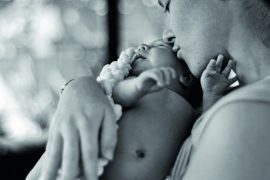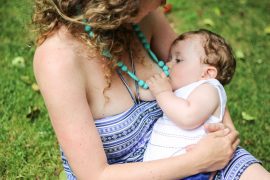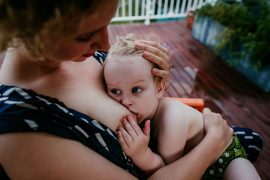The following safety guidelines should be adhered to when bed-sharing and breastsleeping.
Parent/baby considerations:
- Baby should be healthy and full-term
- Mother should be exclusively breastfeeding if baby is under 6 months old (no formula or solids)
- Both parents should be sober and not under the influence of smoking/drugs/alcohol/prescription drugs
- Mother should not have smoked during pregnancy
- Neither parent should be obese
- Baby should not be swaddled
- Baby should be on his back (some will sleep on their side with their face to the breast as well)
For more information on safe bed-sharing, visit:
https://cosleeping.nd.edu/safe-co-sleeping-guidelines/
And http://breastfeedingtoday-llli.org/the-safe-sleep-seven/
COMFORTING
“The few psychological studies which are available suggest that children who have ‘co-slept’ in a loving and safe environment become better adjusted adults than those who were encouraged to sleep without parental contact or reassurance.” – James McKenna
Bed-sharing and breastfeeding at night provide not only physical health benefits to mum and baby, but also emotional and psychological benefits. Human babies are wired to receive nearly constant touch for the first months of life, and skin-to-skin contact increases oxytocin, the hormone of love and attachment, while decreasing stress levels in both babies and mothers.
Babies’ needs for touch continue throughout the night, and studies have shown that when babies are left untouched for longer periods, DNA synthesis halts and growth hormones diminish (Shanberg, 1995). Nils Bergman, the founder of Kangaroo Care, and an avid proponent of skin-to-skin, found that: “Babies separated even by only one metre from mother in a crib at the bottom of mum’s bed show double the levels of the stress hormone cortisol.”
When mothers are responsive to their babies at night, babies learn that the world is a safe and trustworthy place, and that their needs are valid and important. The continual care and comfort a baby needs at night in order for optimal brain development is well documented, and should not be overlooked when deciding where babies will sleep. Breastsleeping arrangements provide an efficient and convenient situation for breastfeeding families, promoting bonding, sensitivity, and a secure emotional attachment.
It is imperative that we challenge cultural bias, and inform parents of the real risks and benefits of each situation, so that they can make the best decision for their family.
You can help normalize breastsleeping by sharing this article with new parents, and ordering a “Normalize Breastsleeping” T-shirt here: http://www.bonfire.com/normalize-breastsleeping
REFERENCES:
http://healthland.time.com/2013/10/01/despite-dangers-bed-sharing-with-kids-is-on-the-rise/
Buckley, S. McKenna, J. (2009) Who Wants to Sleep Alone? New Evidence in Support of Cosleeping and the Family Bed. Mothering Magazine Issue 152
https://cosleeping.nd.edu/assets/25460/shared_sleep_reprint.pdf
McKenna, J., Thoman, E. B., Anders, T. F., Sadeh, A., Schectman, V. L., & Glotzbach, S. F. (1993). “Infant-parent co-sleeping in an evolutionary perspective: Implications for understanding infant sleep development and the sudden infant death syndrome.” Sleep, 16, 263-282.
“Safe Sleep 7” http://breastfeedingtoday-llli.org/the-safe-sleep-seven/
Schanberg, S. (1995). The genetic basis for touch effects. In T. Field (Ed.), Touch and Early Experience (pp. 67-80). Mahwah, NJ: Erlbaum.
Sutherland, Margot. (2016) The Science of Parenting. Dorling Kindersley Limited
Originally published on The Attachment Parenting Podcast.
Megan McCue is a mom, speech-language pathologist, and “Attached at the Heart” parent educator certified through Attachment Parenting International. She hosts The Attachment Parenting Podcast.










